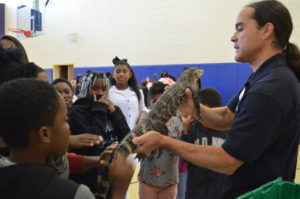Environmental outreach at SRS continues to grow

A team of environmental educators reached over 60,000 individuals last year through an outreach program supported by EM funding at the Savannah River Site .
Team members with the University of Georgia’s Savannah River Ecology Laboratory program educate the public about the animal and plant diversity surrounding the site’s operations and the ecosystem in neighboring communities.
Pacifico Perea, the program manager for SREL, said the team reached between 35,000 and 40,000 individuals in previous years, but with expanded programming and staff, SREL has surpassed those numbers.
“Our educational offerings have diversified from a primarily amphibian- and reptile-focused program to programs that reflect the broad range of wildlife seen across the SRS,” Perea said. “We also highlight the research the lab conducts to monitor, manage, and protect the habitats that these animals call home.”
Perea said that adding topics of current ecological concern, like the decline of pollinators and threatened and endangered species, has contributed to the program’s growth. These topics add to the lab’s original programming that includes wildlife safety talks for site employees and adults in the local communities.
Programs for students from kindergarten through high school have titles such as “Ecologist for a Day” and “EcoTalk,” teaching ecological science through live animal presentations and interactive activities.
“Let’s Grow Together” is a program that educates students about pollinators and their role in plant growth. The program is a collaboration with the U.S. Forest Service–Savannah River.
Perea said such collaborations are key to the lab program’s growth.
In addition to working with the USFS-SR, SREL partners with other organizations like the STEM Community Coalition, a national grant-awarded program developed to reach students in rural and low-income communities that are underserved in science education.
According to Perea, SREL’s outreach program has always sought to meet needs through partnerships. In 2017, SREL began partnering with a Georgia non-profit organization to educate residents in Waynesboro, Georgia about environmental monitoring programs in their area.
Megan Winzeler, the program’s coordinator, said the Radiological Education, Monitoring, and Outreach Project differs from the lab’s other outreach programs that focus on wildlife. REMOP focuses on natural resources — air, water, and soil.
Winzeler said the project’s goal is to equip residents to read and understand the technical reports produced by radionuclide monitoring programs in the local region run by DOE and the South Carolina Department of Health and Environmental Control. She said REMOP has reached more than 750 individuals in a year.
Perea said the team has seen other successes. He noted that Sean Poppy, the outreach coordinator, was recently awarded South Carolina’s environmental awareness award.
“Since Sean has been doing this job for more than 20 years, we are seeing young biologists that cite his influence in their career path,” said Perea. “This is evidence that we are making a huge difference in telling the story of the Savannah River Site.”
